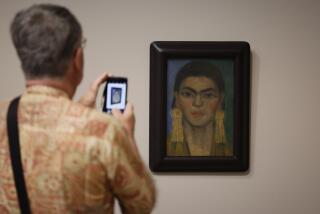‘Breakfast With Lucian’ presents an eye-popping portrait of Freud, the painter
- Share via
“Breakfast with Lucian,” Geordie Greig’s juicy, eye-popping book about Lucian Freud, the notoriously priapic painter best known for raw portraits that stripped his sitters bare in every sense, doesn’t pretend to be objective or comprehensive. Greig offers a fond but by no means whitewashed account of how Freud’s spectacularly messy life relates to his extraordinary body of work as “the greatest realist figurative painter of the twentieth century.”
A grandson of Sigmund Freud, the budding artist escaped from Nazi Germany to England with his family when he was 10, in 1933. Greig writes, “Just like Sigmund, it was Lucian’s business to get people to sit on beds or couches, and to reveal more about themselves than perhaps they wished to show.”
Two years after the artist’s death at 88, Greig, an arts journalist and editor who worked his way into Freud’s confidence in the last 10 years of his life, reveals more about him than this adamantly private man might have wished to show. “Breakfast with Lucian” is at once broader in scope and more personal than art critic Martin Gaylord’s fascinating 2010 book “Man with a Blue Scarf: On Sitting for a Portrait by Lucian Freud.”
Bookshelf: Sign up for our email newsletter
Greig makes the case that the closely connected obsessions that drove Freud were painting and sex, and he analyzes his art and “mind-boggling merry-go-round of liaisons” with equal finesse and fervor. That said, he reminds us that “In trying to understand the complexity that is Lucian Freud, it is necessary to stay focused on his art. The pictures tell who he slept with and spent time with. He mostly kept the names hidden but the paintings don’t lie.”
Freud got away with what Greig calls his “blatantly selfish life” by essentially charming the pants off people and then keeping his scores of lovers — and the many children they produced — hidden from one another. Freud dated 17-year-olds when he was 16 and continued to bed 17-year-olds well into his 70s. Many were younger than his daughters. Indeed, some were the daughters of former lovers or the girlfriends of the sons of former lovers.
“This was musical beds on a grand and anarchic scale,” Greig writes, adding that Freud was “a relentless and somewhat cruel lover” but also “one of life’s eels, always wriggling away from any and every grasp.”
While not all of his models had sex with him, nearly all of his lovers modeled for him. The process was both an excruciating test of endurance and a path to further intimacy — and, as it turned out, immortality in oil. Greig explains: “It was never easy. Paint for Lucian was ‘pain’ with a ‘t’ on the end, as one of his sitters noted.”
Along with Freud’s sexual profligacy and self-destructive passion for gambling, Greig captures the intensity of the artist’s ambition and drive, his exacting work ethic and his numerous “splintered” friendships, including with fellow artist Francis Bacon. Greig’s own friendship with Freud provides access to the chaos and squalor of his home and studio — littered with used brushes, flicked paint splotches and the carcasses of half-eaten dinners. His portrait comes alive with descriptions of Freud’s “ferret-thin figure,” “shabby-chic style,” penchant for silk scarves, nougat candy, wads of cash and hair-raising drives in his brown Bentley.
Freud’s outrageous, egregious behavior comes through more clearly than his oft-cited charm and magnetism. And although Greig surely deserves some sort of patience award for untangling Freud’s snarled web of lovers, the bodies pile up not just alarmingly but a smidge tediously. (A notable exception is Guinness heiress Lady Caroline Blackwood, Freud’s second and last wife, whose story Greig manages to follow all the way to her deathbed because of his relationship with her daughter, Ivana.)
The book becomes even more interesting when it turns to Freud’s offspring — 14 of whom he acknowledged, borne by six mothers between 1948 and 1984. An appended family tree helps keep them straight, including the three born to three mothers in 1961. Greig says the numbers are no doubt higher, perhaps as great as 40.
Six daughters and one son posed naked for their father. “Journalists had a field day trying to explain the Freudian significance of children in their teens or early adulthood stripping bare for their father,” Greig writes. Yet he contends that, although Freud’s children craved more of him than he gave, “they all fell under his spell” and most “loved him unreservedly, despite all his obvious failures and complications as a father.”
When he died in 2011, several had never met one another. All 14 were left equal portions of his staggering 96 million pounds estate.
Some may argue that paintings like “Hotel Bedroom,” “Naked Man with Rat” and “And the Bridegroom” require neither explanations nor back-stories to convey their power. But Greig’s book, a rare case in which the text and illustrations are equally gripping, brings into sharp focus this bold iconoclast who “pushed boundaries, artistic as well as sexual.” Even better, it makes us look more closely and deeply — and see more.
McAlpin reviews books regularly for NPR.org and the Washington Post and writes the Reading in Common column for the Barnes & Noble Review.
Breakfast With Lucian
The Astounding Life and Outrageous Times of Britain’s Great Modern Painter
Geordie Greig
Farrar, Straus & Giroux, 260 pp, $30
More to Read
Sign up for our Book Club newsletter
Get the latest news, events and more from the Los Angeles Times Book Club, and help us get L.A. reading and talking.
You may occasionally receive promotional content from the Los Angeles Times.








